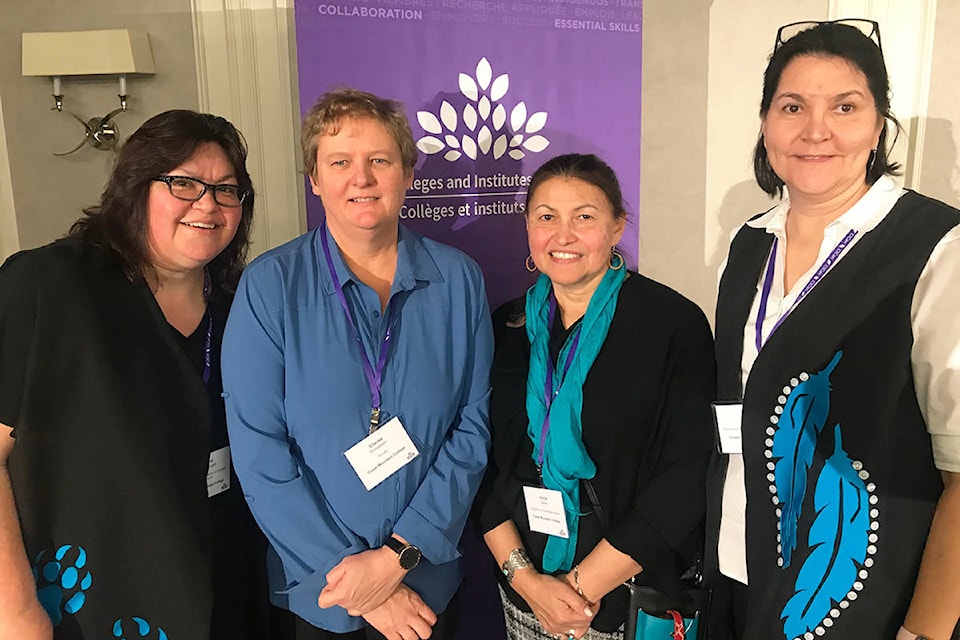Coast Mountain College’s work to indigenize its curriculum and provide more support for Indigenous students saw international attention at an education symposium earlier this month.
Representatives from Northwest B.C. shared examples of their efforts at the 2019 Indigenous Education Symposium, where educators from across Canada and internationally gathered from Nov. 4-6.
Bridie O’Brien, CMTN’s executive director of indigenization, Ali McDougall, Indigenous relations and executive advisor to the president’s office, Sheree Ronaasen, university credit professor and Ska’yan (Anita Davis), a Gitxsan hereditary chief, all made presentations on Nov. 5.
“We’ve learned that we have been on the right track, and we’re making great progress,” says O’Brien.
“At the end of our presentation we received feedback from a Métis elder who was very emotional and moved by seeing all that we are doing at CMTN, because coming from his personal experience, he never imagined that we could come this far.”
READ MORE: New mobile training unit coming to Coast Mountain College
Through similar efforts, universities and colleges have the opportunity to advance reconciliation and strengthen relationships in their own communities, O’Brien says.
“It is an opportunity for us to shift perspectives and create awareness and understanding about the truth and the history of the relationship that this country has with Indigenous people,” she says.
Indigenous students make up between 38 to 49 per cent of CMTN’s student population, depending on how many have self-declared, according to communications director Sarah Zimmerman.
The first step for educators? Building lasting relationships with local First Nation communities.
“Making sure that your Indigenous communities are part of the idea right from the onset, and it’s built together,” O’Brien says.
For example, one of the speakers, Ska’yan, has hosted the People of the Skeena Field School at the culture camp she runs on the banks of the Skeena River in Terrace for more than a decade.
There, students immerse themselves in Gitxsan culture and history, while learning about the traditional usages of plants, including the tree of life, cedar weaving, and other traditional activities, such as the preparation of smoked salmon.
CMTN has several other programs with an Indigenous focus, including its world-renowned Freda Diesing School of Northwest Coast Art, early childhood and development, criminology, and art history. To support students, the college also has an Indigenous support team, scholarships and bursaries, First Nation access coordinators to connect students with services, and workshops to reconnect students with their culture.
READ MORE: Northwest Coast Art from Freda Diesing students showcased at Terrace Art Gallery
Authenticity is one of the most important aspects for educational institutions when it comes to incorporating Indigenous perspectives, O’Brien says.
Much of the work that has been done has involved CMTN’s First Nations Council which has representatives from across the region to provide advice and guidance to programs and services, a model that could be beneficial for other university and college campuses.
And for the last three years at CMTN, campus staff have used the Truth and Reconciliation Commission’s 94 Calls to Action as a way of measuring their own progress in programming and training. New positions and titles have been created to support management, and the college is now hoping to hire someone to help bridge the gap between Indigenous culture and knowledge, and curriculum taught in the classroom.
Coming out of the symposium, O’Brien says she believes CMTN is leading the way when it comes to implementing strategies and techniques to address the absence of Indigenous ways of knowledge in curriculums across Canada.
“Any institution will tell you, there’s no textbook in how to indigenize your institution, there’s no template,” she says.
“Indigenization is the effort and the process made by every individual at CMTN. It’s not the responsibility of a department or a few people — it’s up to all of us.”
brittany@terracestandard.com
Like us on Facebook and follow us on Twitter
